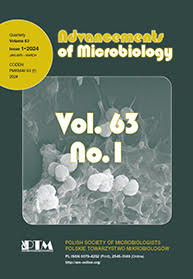1. Białka Dsb (disulfide bond). 2. Różnorodność procesu biogenezy cytochromów c w komórkach bakteryjnych. 2.1. Transport i redukcja apocytochromu. 2.2. Transport i przyłączanie hemu do zredukowanego apocytochromu. 3. Podsumowanie
Abstract: The bacterial proteins of the Dsb family catalyze the formation of disulfide bridges, a post-translational modification of many extracytoplasmic proteins, leading to stabilization of their tertiary and quaternary structures. In Gram-negative bacteria this process takes place in the periplasm whereas in Gram-positive bacteria it occurs in the analogous space between the cytoplasmic membrane and the cell wall. In E. coli (Ec) the Dsb system operates in two partially coinciding metabolic pathways: the oxidation (DsbA and DsbB) and the isomerization/reduction (DsbC and DsbD). In the highly oxidizing environment of the periplasm, there is also a need for selected proteins to be kept in a reduced form. Assembly of c-type cytochromes, essential for energy metabolism, is a case of point. Two distinct different systems for cytochrome-c maturation was found in bacteria: system I known as Ccm (cytochrome c maturation) and system II known as Ccs system (cytochrome c synthesis). They comprise two kind of proteins: those contributing to transport and reduction of disulfide bond of CXXCH of apocytochrome c and those involved in handling of heme and playing a role in its ligation to the apocytochrome. The cytochrome c maturation process requires ligation of heme to reduced thiols of the Cys-X-X-Cys-His motif of the apocytochrome. Since DsbA, the main periplasmic dithiol-oxidase randomly introduces disulfide bonds into apocytochromes, bacterial evolved a special redox system to revert these disulfides, in highly oxidizing environment, into reduced cysteine residues. Thiol-oxidoreductases, CcmG proteins, previously designated as DsbE, play a key role in this process. Here we discuss the variety of two cytochrome c biogenesis systems and discuss some of the current problems in understanding how the process works putting special emphasis on the recent achievements concerning the process driving by CcmGs.
1. Dsb proteins. 2. Diversity of cytochrome c biogenesis. 2.1 Transport and reduction of apocytochrome c. 2.2 Heme translocation and ligation into reduced apocytochrome. 3. Conclusions

